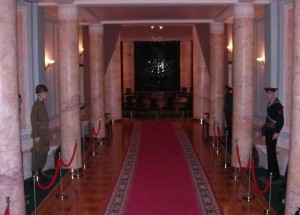25 October Stalin’s Bunker
 Stalin’s Bunker located in Izmailovo, Moscow was a backup Command Post for the Red Army Supreme Commander, Joseph Stalin, during the Great Patriotic War (Eastern Front of the Second World War 1941-1945)
Stalin’s Bunker located in Izmailovo, Moscow was a backup Command Post for the Red Army Supreme Commander, Joseph Stalin, during the Great Patriotic War (Eastern Front of the Second World War 1941-1945)
Built in the 1930s under a shroud of great secrecy, the clandestine command and control bunker was only opened to the public in 1996. Its construction was part of the Politburo’s program to ensure the defensive capaBility of the Soviet Union against Nazi Germany. The facility is linked to the centre of Moscow by a 17 km -long underground road.
The designers of the bunker chose a sports stadium to camouflage the facility’s true purpose, a deception ordered by Stalin, because perversely he believed Hitler wouldn’t bomb sports stadia.
The USSR had its own version of the Olympics or Commonwealth Games where competitors from the Republics vied for honors. Under the guise of building a new facility to house the Soviet Games “Spartaiada”, the Politburo announced the construction of a suitable venue.
The stadium was supposed to seat 120 000 spectators and provide training facilities for many different sports. It was also to become multi-functional and host folk festivals, pageants and military parades. Following its opening the Soviets planned building a Sports Palace hosting scientific research into sports.
Construction started in 1936 and was put on hold in 1939 following the outbreak of war with Finland. When the Finnish war had started one 10,000 capacity grandstand and the underground facilities including the Stalin’s Bunker had been completed. Construction was not resumed until the 1960’s; but the fact that the facility was already obsolete (nuclear weapons of the era put paid to any pretense of safety for the leaders) and a lack of finance precluded completion of the secret project. In addition, another Stadium, named after Lenin in Luzhniki, had already been completed.
When: we meet outside Partizanskaya metro station at 15.45h
Cost: 2100 rub per person
